Books
Books
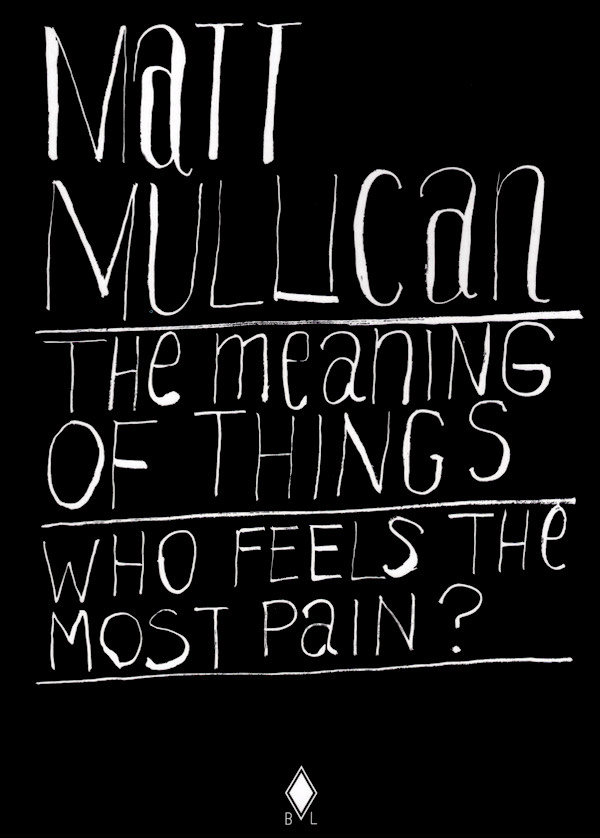
The Meaning of Things (who feels the most pain?)
This artist's book is the book-form of a work by Matt Mullican, "The Meaning of Things (who feels the most pain?)" (2014), consisting of 676 collages and texts on sheets of standard printing paper.
At the approximate center of each collage is a small image that appears to be a printout of an image procured from the Internet. Around the images are hand-drawn, quasi-calligraphic marks (in black only), curved, giving the impression of an "organic" form in the manner of ornate, rococo frames. The series develops a narrative of interests, practices and collective representations that suggest and disavow each other. Mullican deftly challenges this simple to-and-froing of "virtual" and "real" by suspending the idea that only through the material/physical printing out of the digital images, the content of the images is "restored" back into the "real"—to grasp the "meaning of things" comes at the price of "feeling the most pain".
Working in the fields of performance, installation, digital technology and sculpture, Matt Mullican (born 1951 in Santa Monica, lives an works in New York) is seeking to develop a cosmological model based on a personal vocabulary combining the formal and the symbolic. Hypnosis and cartography are his principal modes of operation. He explores functional sign systems of his own devising through activities under hypnosis, in a permanent oscillation between the real and its schematization, between fiction and its physical reality.
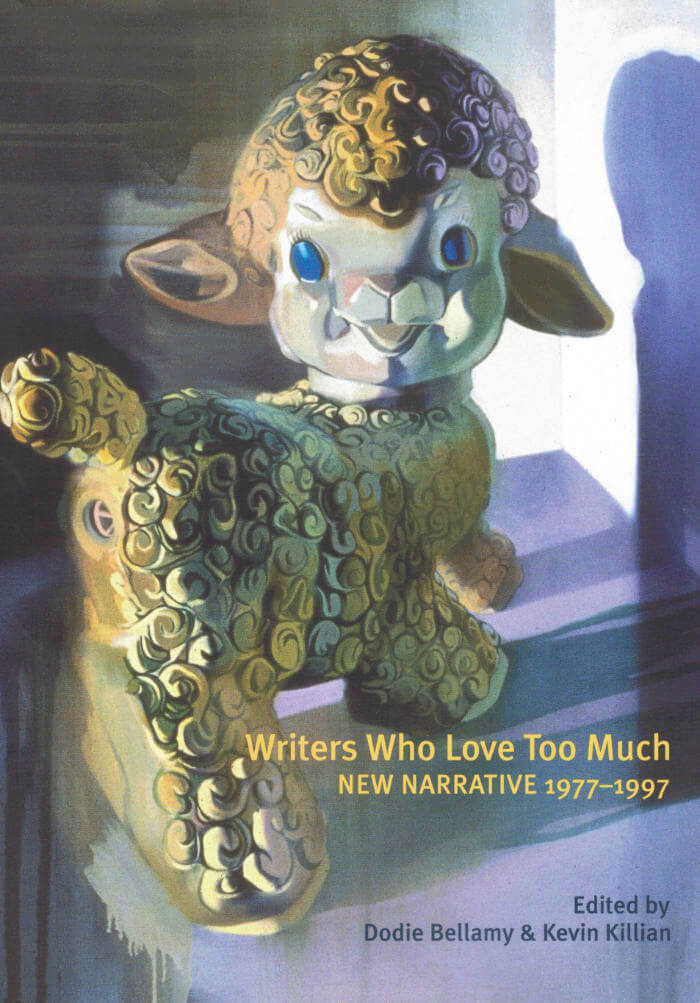
Writers Who Love Too Much: New Narrative 1977-1997
This long overdue anthology of New Narrative includes both classic New Narrative texts and rare supplementary materials, allowing the movement fueled by punk, pop, porn, French theory, and social struggle to bound back to life, ripe with dramatic propulsion, to form a new map of late 20th century creative rebellion.
"Gossipy and uninhibited, its breath is hot in your ear. It wants to tell you everything, and it wants you to overshare back." — M. Milks
"One of New Narrative's all-time best jokes is about the movement itself. It's the parodic motto that Bellamy formulates in Academonia for New Narrative "at its worst" "I have sex and I'm smarter than you." But "sex without fantasy," Camille Roy posits, "is nothing." The pieces compiled in Writers Who Love Too Much don't restrict fantasy. They use, as Boone says, eros, rather than facts, as the matter of narrative. Sex and fantasy are for New Narrative the stuff of ordinary life." — Jean-Thomas Trembla
Contributors include: Steve Abbott, Kathy Acker, Michael Amnasan, Roberto Bedoya, Dodie Bellamy, Bruce Benderson, Charles Bernstein, Nayland Blake, Bruce Boone, Lawrence Braithwaite, Rebecca Brown, Kathe Burkhart, Marsha Campbell, Dennis Cooper, Sam D'Allesandro, Gabrielle Daniels, Leslie Dick, Cecilia Dougherty, Bob Flanagan, Robert Glück, Judy Grahn, Brad Gooch, Carla Harryman, Richard Hawkins, Ishmael Houston-Jones, Gary Indiana, Edith A. Jenkins, Kevin Killian, Chris Kraus, R. Zamora Linmark, Eileen Myles, John Norton, F.S. Rosa, Camille Roy, Sarah Schulman, Gail Scott, David O. Steinberg, Lynne Tillman, Matias Viegener, Scott Watson, Laurie Weeks.
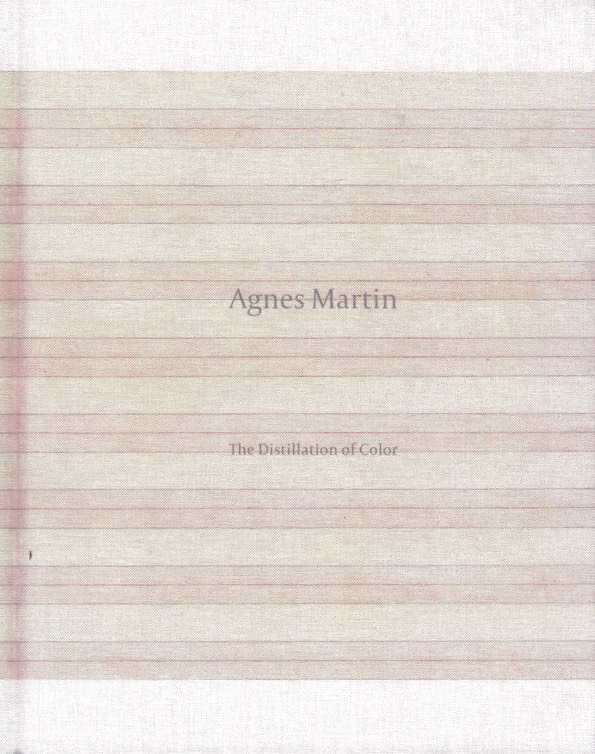
The Distillation of Color
This handsomely designed, concise volume celebrates Agnes Martin's pursuit of beauty, happiness and innocence in her nonobjective art created while living in the desert of New Mexico. From her multicolored striped works to compositions of color-washed bands defined by hand-drawn lines, to the deep gray Black Paintings that characterized her work in the late 1980s, Martin's treatment of color in each of these phases is examined.
A particular emphasis is placed on the latter half of her career and the broadening vision that developed during her years working in the desert, which crystalized her quest to deepen her understanding of the essence of painting, unattached to emotion or subject, yet radiant and meditative in its pure abstraction.
With editorial contributions by a selection of writers whose cross-genre works span art writing, essay and memoir, this book expands an approach to Martin's paintings beyond a purely art historical lens, bringing new voices into the conversations around her career, inviting a rediscovery of her enduring legacy. An essay by author Durga Chew-Bose provides a poetic exploration of color; the writer Olivia Laing (author of The Lonely City) discusses the nature of solitude in her text; and Bruce Hainley uses a 1974 essay by Jill Johnston as a jumping-off point to delve into Martin's life during her years in New Mexico.
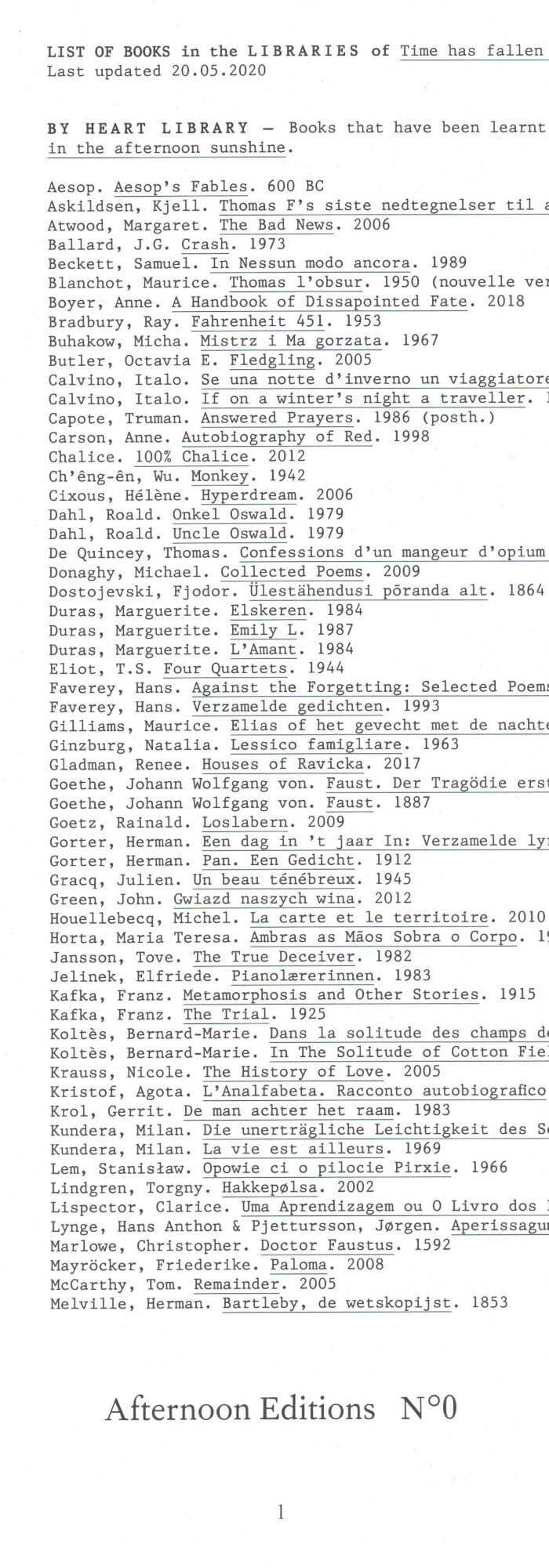
LIST OF BOOKS in the LIBRARIES of Time has fallen asleep in the afternoon sunshine
Afternoon Editions no. 0: List of books in the library of Time has fallen asleep in the afternoon sunshine. The list consists of books that have been leart by heart within the project (by heart library), an incomplete list of books that were considered to be leart by heart, that played an important role in the process of choice, or that have been considered to be learnt by heart in the future (shadow library), a growing collection of literature, publications, essays, films, ephemera relating to interests within the project (reference library).
Edition last updated May 2020.

Bookmarks of sorts
Afternoon Editions no. 5: a collection of found papers annotated by Jeroen Peeters, titled Bookmarks of sorts. During several years Jeroen Peeters collected notes left by readers in library books: faded reader tickets, scraps with notes, a shopping list, train tickets and other little papers used as bookmarks. He noted each time the date and the book in which they were found. Afterwards he wrote commentaries to this collection, an essay on alternative reading practices, marginalia and extra-illustration, on the exchange between readers and the imaginary community lingering in all those library books.

Weaknesses
Afternoon Editions no. 2: text and drawings by Chrysa Parkinson titled Weaknesses. Between January and March 2019 Time has fallen asleep in the afternoon sunshine was presented as a solo-exhibition at Index Foundation in Stockholm. During this period Chrysa Parkinson was invited as a guest writer for Afternoon Editions. Weaknesses is a leap in memory.

The Undercommons: Fugitive Planning and Black Study
In this series of essays Fred Moten and Stefano Harney draw on the theory and practice of the black radical tradition as it supports, inspires, and extends contemporary social and political thought and aesthetic critique. Today the general wealth of social life finds itself confronted by mutations in the mechanisms of control, from the proliferation of capitalist logistics through governance by credit and management of pedagogy.
Working from and within the social poesis of life in the undercommons Moten and Harney develop and expand an array of concepts: study, debt, surround, planning, and the shipped. On the fugitive path of an historical and global blackness, the essays in this volume unsettle and invite the reader to the self-organised ensembles of social life that are launched every day and every night amid the general antagonism of the undercommons.
Published 2013.

On the Self-Reflexive Page II
Originally published in 2010, ‘On the Self-Reflexive Page’ is part artist’s book and part essay, part literary excavation and part typographical miscellany. For this second incarnation of Louis Lüthi’s anthology of thematically arranged pages, the original material has been significantly expanded and revised. Like its predecessor, the new version proposes a typology of nonverbal elements found in novels, short stories, and essays. In each of the pages reproduced here, the prose is interrupted by one of these nonverbal elements, from black or blank pages, drawings or collages, photographs or film stills, to fragments of text or visual poems that are distinct from a conventional page layout.

The Way of Love
The Way of Love asks the question: How can we love each other? Here Luce Irigaray, one of the world's foremost philosophers, presents an extraordinary exploration of desire and the human heart. If Western philosophy has claimed to be a love of wisdom, it has forgotten to become a wisdom of love. We still lack words, gestures, ways of doing or thinking to approach one another as humans, to enter into dialogue, to build a world where we can live together.
Luce Irigaray is Director of Research in Philosophy at the Centre National de la Recherche Scientifique, Paris. A doctor of philosophy, Luce Irigaray is also trained in linguistics, philology, psychology and psychoanalysis. Now acknowledged as a key influential thinker of our times, her work focuses on the culture of two subjects, masculine and feminine - particularly through the liberation of a feminine subjectivity - something she explores in a range of literary forms, from the philosophical to the scientific, the political and the poetic.
Published 2004.

Pieces of a Song: selected poems
Feminist Beat poet Diane di Prima was born in Brooklyn, New York. She attended Swarthmore College for two years before moving to Greenwich Village in Manhattan and becoming a writer in the emerging Beat movement. There, she developed friendships with poets Amiri Baraka, Allen Ginsberg, Jack Kerouac, Frank O'Hara and Audre Lorde. After joining Timothy Leary's intentional community in upstate New York, she moved to San Francisco in 1968. One of her collections of poetry, The Poetry Deal, is also published by City Lights Publishers. Di Prima was named Poet Laureate of San Francisco in 2009. She has been awarded the National Poetry Association's Lifetime Service Award and the Fred Cody Award for Lifetime Achievement and has also received grants from the National Endowment for the Arts, the Committee on Poetry, the Lapis Foundation and the Institute for Aesthetic Development. St. Lawrence University granted her an honorary doctorate.
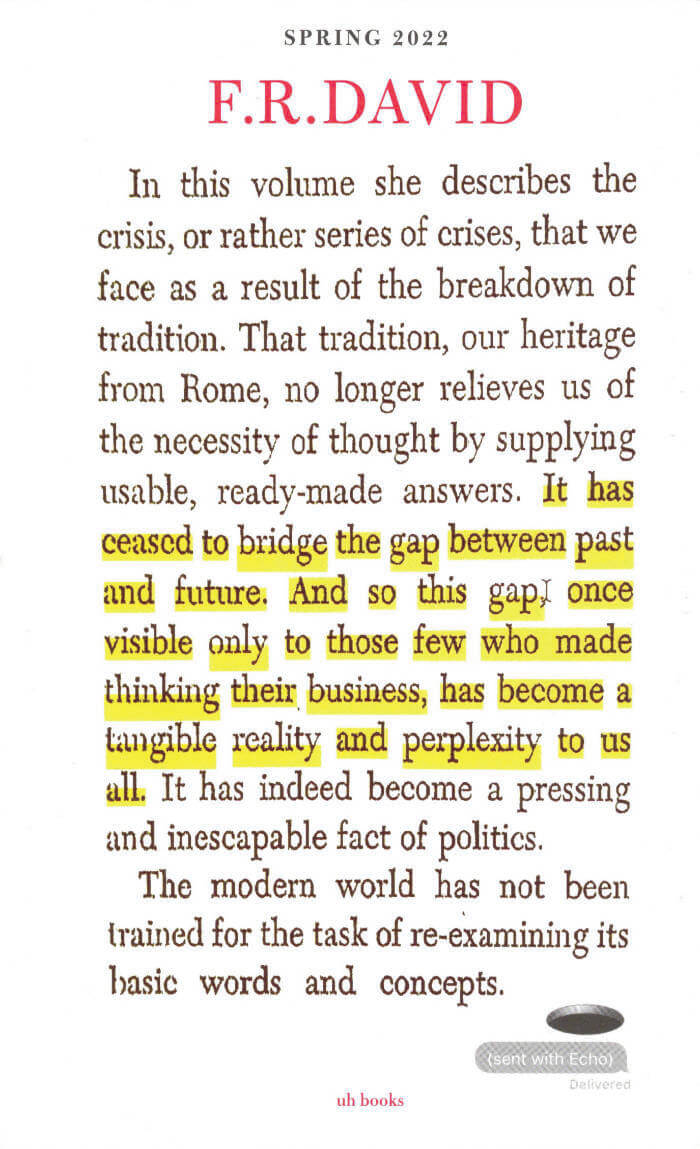
F.R. David - "Take, Eat"
Will Holder, Andrea di Serego Alighieri
F.R.DAVID is a typographical journal, dealing with the organisation of reading and writing in contemporary art practises.
The 21st issue, “Take, Eat” is edited by Will Holder, with Andrea di Serego Alighieri. Andrea’s image-heavy talk on word spacing and vocalisation runs all the way through, on the right-hand pages: the opposite pages contain responses from Will. The issue almost stifles the triangulated space of image, context and commentary; and speaks of the moment between words, things, people, images, perception, past, present and future, between Andrea’s pages and Will’s, as where meaning might breathe.

Self-portrait
Allison Grimaldi Donahue, Carla Lonzi
Recorded and transcribed throughout the 1960s, Carla Lonzi’s Self-portrait ruptures the narration of post-war modern art in Italy and beyond. Artmaking struck Lonzi as an invitation to be together in a ‘humanly satisfying way’, and this experiment in art-historical writing is a testament to her belief. Lonzi abolishes the role of the critic, her own, seeking change over self-preservation by theorising against the act of theorising.
The life and work of Carla Lonzi (1931–1982) is inseparable from the cultural, political, and social history of Italy in the decades following the Second World War; she occupies a singular position, which today merits reevaluation. A reputed art critic of the 1960s artistic scene, both friend and collaborator of such figures as Carla Accardi, Luciano Fabro, Giulio Paolini, and Jannis Kounellis, she wrote “Autoportrait” in 1969, a “love letter” to the artists and to creation, but also a farewell chorus to art criticism and the art world. The following year she founded Rivolta Femminile, an active feminist collective, thus becoming the central figure of Italian feminism.
Interviews with Carla Accardi, Getulio Alviani, Enrico Castellani, Pietro Consagra, Luciano Fabro, Lucio Fontana, Jannis Kounellis, Mario Nigro, Guilio Paolini, Pino Pascali, Mimmo Rotella, Salvatore Scarpita, Guilio Turcato, Cy Twombly.
Afterword by Claire Fontaine.
Translated by Allison Grimaldi Donahue.
978-1916425088
105 b&w illustrations
21.6 x 13.9 cm
364 p.
Paperback
November 2021
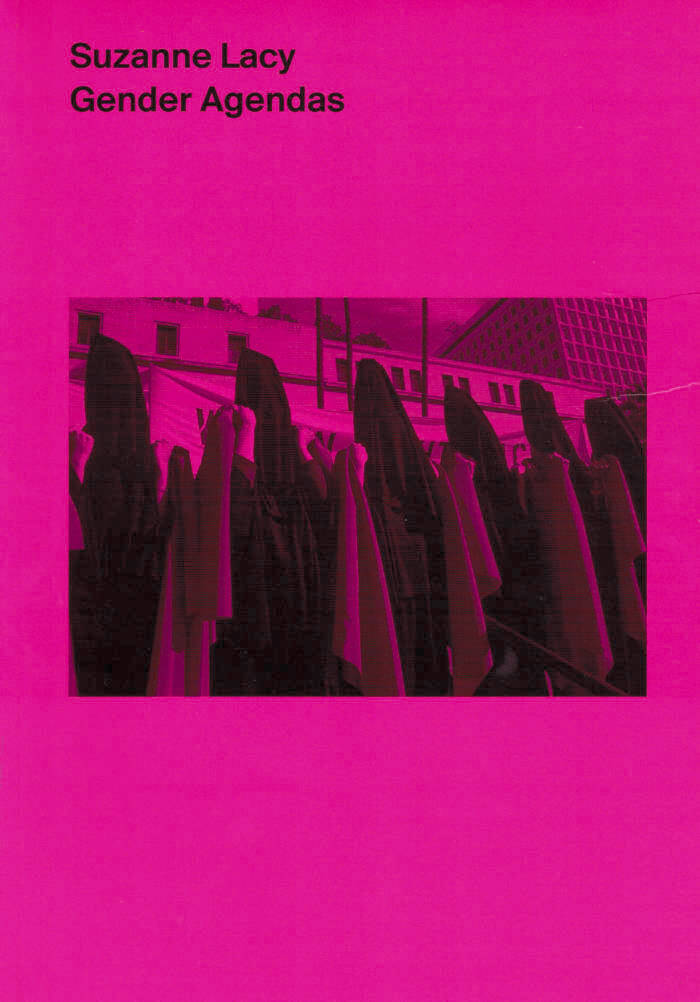
Gender Agendas
Comprehensive monograph of the Californian artist and political activist.
This book covers Suzanne Lacy's whole career, presenting a selection of her major projects: from the pioneering Prostitution Notes (1974), an artwork that combines conceptual and performance art with social commitment focused on the theme of prostitution exploitation in some areas of Los Angeles, to Crystal Quilt(1985-1987), probably Lacy's most famous work, a huge performance which involved 430 women over 60 seated at tables arranged in the pattern of a large quilt created by Miriam Shapiro, mingling their memories with sociological analyses of society's failure to exploit the potential of old age, to Storing Rape(2012), a discussion among important media personalities, activists and politicians in the attempt to find a different way of describing sexual violence.
Published on the occasion of the eponymous exhibition (Suzanne Lacy's first major European exhibition) at Museo Pecci Milano, in 2014-2015.
Suzanne Lacy (born 1945 in Wasco, USA, lives and works in Los Angeles) is a visual artist whose prolific career includes performances, video and photographic installation, critical writing and public practices in communities. She is best known as one of the Los Angeles performance artists who began active in the Seventies and shaped and emergent art of social engagement. Her work ranges from intimate, graphic body explorations to large-scale public performances involving literally hundreds of performers and thousands of audience members. She has published over 70 texts of critical commentary, and has exhibited in The Museum of Contemporary Art in Los Angeles, The New Museum and P.S. 1 in New York, and The Bilbao Museum in Spain.

The Spring Flowers Own & The Manifestations of the Voyage
“The Spring Flowers Own” and “The Manifestations of the Voyage” continue and complete the Cycle of the Linden Tree, which started with two poems previously published in The Indian Never Had a Horse & Other Poems: “One Linden Tree, Then Another Linden Tree,” and “An Alley of Linden Trees, and Lightning.”
Etel Adnan was born in Beirut, Lebanon in 1925, the daughter of a Greek Christian from Smyrna and a high-ranking Ottoman officer from Damascus. She passed away in November 2021. Her work as a whole is a faithful record of the times and places she has lived in Beirut, Paris, and in the San Francisco Bay Area. At least eighteen works by Adnan have been published in English. They include SITT MARIE ROSE (Post-Apollo Press, 1982); THE ARAB APOCALYPSE (Post-Apollo Press, 1989); SEA AND FOG (Nightboat Books, 2012), winner of the Lambda Literary Award for Lesbian Poetry and the California Book Award for Poetry; and PREMONITION (Kelsey Street Press, 2014). Nightboat Books published the 2-volume set, TO LOOK AT THE SEA IS TO BECOME WHAT ONE IS: AN ETEL ADNAN READER, in 2014. In 2011, Adnan received Small Press Traffic's Lifetime Achievement Award. Her paintings, described by New York Times art critic Roberta Smith as stubbornly radiant abstractions, have been widely exhibited, most recently at Documenta 13 and in the 2014 Whitney Biennial. Spanning media and genres, Adnan's writings have led to numerous collaborations with artists and musicians, including the French part of CIVIL WarS, a multi-language opera by American stage director Robert Wilson, performed in Lyon and Bobigny in 1985.
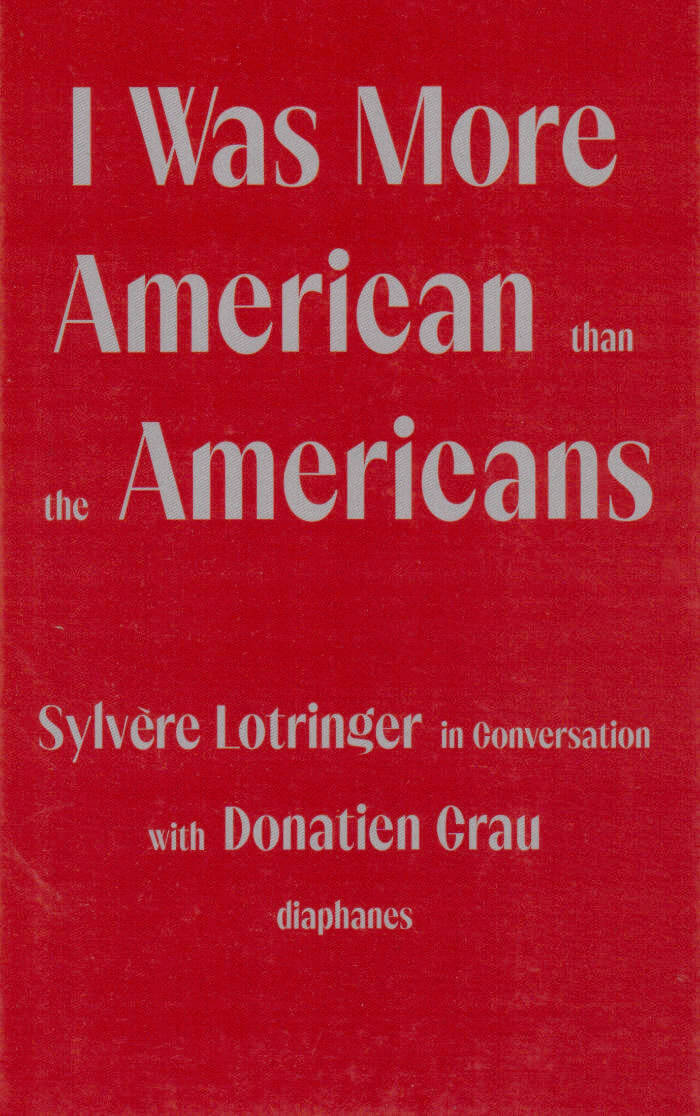
I Was More American than the Americans
Sylvère Lotringer, Donatien Grau
A personal take on French Theory by one of the people who invented it.
In the mid-1970s, Sylvère Lotringer created Semiotext(e), a philosophical group that became a magazine and then a publishing house. Since its creation, Semio-text(e) has been a place of stimulating dialogue between artists and philosophers, and for the past fifty years, much of American artistic and intellectual life has depended on it. The model of the journal and the publishing house revolves around the notion of the collective, and Lotringer has rarely shared his personal journey: his existence as a hidden child during World War II; the liberating and then traumatic experience of the collective in the kibbutz; his Parisian activism in the 1960s; his time of wandering, that took him, by way of Istanbul, to the United States; and then, of course, his American years, the way he mingled his nightlife with the formal experimentation he invented with Semiotext(e) and with his classes. Since the early 2010s, Donatien Grau has developed the habit of visiting Lotringer during his trips to Los Angeles; some of their dialogs were published or held in public. This book is an entry into Lotringer's life, his friendships, his choices, and his admiration for some of the leading thinkers of our times. The conversations between Lotringer and Grau show bursts of life, traces of a journey, through texts and existence itself, with an unusual intensity.

Transgender Warriors: Making History from Joan of Arc to Marsha P. Johnson and Beyond
This groundbreaking book, far ahead of its time when first published in 1996 and still galvanizing today, interweaves history, memoir, and gender studies to show that transgender people, far from being a modern phenomenon, have always existed and have exerted their influence throughout history. Leslie Feinberg, hirself a lifelong transgender revolutionary, reveals the origin of the check-one-box-only gender system and shows how zie found empowerment in the lives of transgender warriors around the world, from the Two Spirits of the Americas to the many genders of India, from the trans shamans of East Asia to the gender-bending Queen Nzinga of Angola, from Joan of Arc to Marsha P. Johnson and beyond.
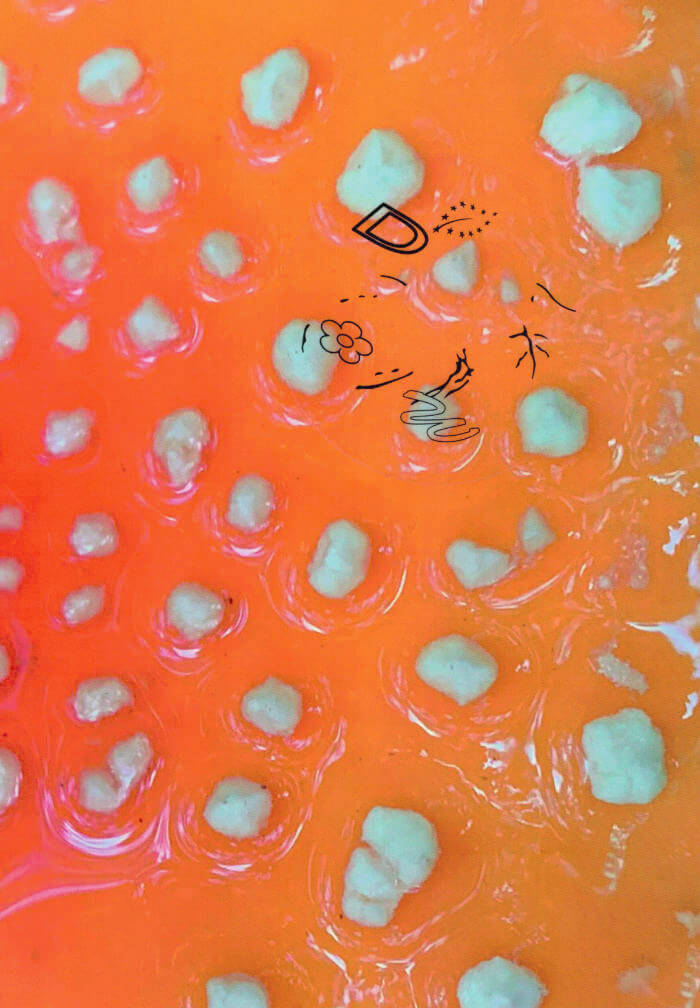
DAISYWORLD MAGAZINE #3
ROT, LANGUAGE & A STRAY BUTTERFLY
CONTRIBUTORS Eady van Acker, Anouk Asselineau & Myrto Vratsanou, Britt Browne, Finca Tierra Negra, Yuri Hasegawa, Celine Caly, Aimilia Efthimiou & Comfy Shrooms, Paige Emery, Elizaveta Federmesser, Edwin Godínez, Meg Hadfield, Freya Häberlein, Johanna Hedva, Zsófia Jakab, Lijuan Klassen, Marijn van der Leeuw, Juliette Lizotte, Niklaus Mettler & Anja Wille-Schori, Hatty Nestor, Kamila Sipika, Zazie Stevens & Alex Valentina.
DAISYWORLD MAGAZINE is a seasonal art publication on perception, the sensory, the non-human, ecology & erotica with an emphasis on interconnectedness. The artist's intimate knowledge based on observation, questioning anthropocentrism through beauty & language. Reflecting on the past season while softly moving into the next, each issue launches in-between seasons; appreciating experience, transition, and metamorphosis instead of anticipating the next big thing
Cover image: Zazie Stevens

I Love Nature
De eerste tekstuitgave van theater- en filmmaker, schrijver, wildplukker en ecoseksueel/klimaatactivist Nora Ramakers, die in haar werk de erotische essentie van de natuur poogt bloot te leggen.

Nachbilder / Reflection pictures
Caravaggio’s Head of Medusa, 1596/97, painted in two versions, not only reflects light but is a painted reflection. Similarly, these photographs are all reflections in plate glass mirror. They document a relation in the present without content.
First edition of 50

Toward The Not-Yet: Art As Public Practice
Jeanne Van Heeswijk, Maria Hlavajova and 1 more
This volume from BAK, basis voor actuele kunst, combines handbook, dictionary, and anthology to investigate artistic practice aimed at achieving social change. With text and visual essays, definitions, exercises, interviews, and images, the contributors envision a praxis that is committed to experimenting with aesthetics and politics in ways that go beyond the conventions of Western modernity. These are practices that are interdisciplinary, theoretically informed, and politically driven, offering ways of being together otherwise. Catalyzed by the work of artist Jeanne van Heeswijk, which focuses on radicalizing civic processes, Toward the Not-Yet imagines and enacts alternative ways of conceiving the present and future.
Contributors, among them notable artists, scholars, activists, and writers consider ways of participating in civic life, including dreamscaping and radical listening; the creation of safer spaces for humans and nonhumans; ways of radically shifting laws and policies; and tactics and methods of collective sanctuary. Toward the Not-Yet is part of BAK's series of BASICS readers, debuting a SUPERBASICS variation that is larger, with more visual content.

Reading / Feeling
Frédérique Bergholtz, Tanja Baudoin
Reading / Feeling examines affect, a term that delineates a field where the personal and political meet in sensory movements between bodies. A pre-emotional experience, affect constitutes the social and economic relationships that make up the fabric of society. Reading / Feeling considers the meaning of affect in theory and artistic practice through texts by theoreticians, artists, and curators read in If I Can’t Dance’s Reading Groups in Amsterdam, Toronto, and Sheffield as part of the programme for Edition IV – Affect (2010–12). It also includes three new essays, short statements by Reading Group members, and artist pages.
Contributors: Sara Ahmed, Rhea Anastas, Lauren Berlant, Leo Bersani, Lone Bertelsen, Gregg Bordowitz, Judith Butler, Jeremiah Day, Gilles Deleuze, Lucien Febvre, Simone Forti, Adam Frank, Andrea Fraser, Félix Guattari, Michael Hardt, Sharon Hayes, Brian Holmes, Jutta Koether, Glenn Ligon, Brian Massumi & Mary Zournazi, Helen Molesworth, Andrew Murphie, Sina Najafi & David Serlin, George Orwell, Emily Roysdon, Eve Kosofsky Sedgwick, Baruch Spinoza, Susan Sontag, Jan Verwoert; it also includes: essays by Tanja Baudoin, Emma Cocker, Jacob Korczynski; contributions by Reading Group members Stephen Bowler, Alison J Carr, Belen Cerezo, Jon Davies, Anik Fournier, Victoria Gray, Linda Kemp, Wjm Kok, Janice McNab, Gabrielle Moser, Cecilia Paldino, Andrew James Patterson, Hester Reeve, Julie Swalloa, cheyanne turions, Vivian Ziherl; and artist pages by Matthew Lutz-Kinoy.

The Summer House Sessions (vinyl LP)
Don Cherry's lost Summer House Sessions finally available over fifty years after they were recorded.
In 1968, Don Cherry had already established himself as one of the leading voices of the avant-garde. Having pioneered free jazz as a member of Ornette Coleman's classic quartet, and with a high profile collaboration with John Coltrane under his belt, the globetrotting jazz trumpeter settled in Sweden with his partner Moki and her daughter Neneh. There, he assembled a group of Swedish musicians and led a series of weekly workshops at the ABF, or Workers' Educational Association, from February to April of 1968, with lessons on extended forms of improvisation including breathing, drones, Turkish rhythms, overtones, silence, natural voices, and Indian scales. That summer, saxophonist and recording engineer Göran Freese—who later recorded Don's classic Organic Music Society and Eternal NowLPs—invited Don, members of his two working bands, and a Turkish drummer to his summer house in Kummelnäs, just outside of Stockholm, for a series of rehearsals and jam sessions that put the prior months' workshops into practice. Long relegated to the status of a mysterious footnote in Don's sessionography, tapes from this session, as well as one professionally mixed tape intended for release, were recently found in the vaults of the Swedish Jazz Archive, and the lost Summer House Sessions are finally available over fifty years after they were recorded.
On July 20, the musicians gathered at Freese's summer house included Bernt Rosengren (tenor saxophone, flutes, clarinet), Tommy Koverhult (tenor saxophone, flutes), Leif Wennerström (drums), and Torbjörn Hultcrantz (bass) from Don's Swedish group; Jacques Thollot (drums) and Kent Carter (bass) from his newly formed international band New York Total Music Company; Bülent Ates (hand drum, drums), who was visiting from Turkey; and Don (pocket trumpet, flutes, percussion) himself. Lacking a common language, the players used music as their common means of communication. In this way, these frenetic and freewheeling sessions anticipate Don's turn to more explicitly pan-ethnic expression, preceding his epochal Eternal Rhythm dates by four months. The octet, comprising musicians from America, France, Sweden, and Turkey, was a perfect vehicle for Don's budding pursuit of "collage music," a concept inspired in part by the shortwave radio on which Don listened to sounds from around the world. Using the collage metaphor, Don eliminated solos and the introduction of tunes, transforming a wealth of melodies, sounds, and rhythms into poetic suites of different moods and changing forms. The Summer House Sessions ensemble joyously layers manifold cultural idioms, traversing the airy peaks and serene valleys of Cherry's earthly vision.

Anarchy – In a Manner of Speaking
David Graeber's interviews (with Mehdi Belhaj Kacem, Nika Dubrovsky, and Assia Turquier-Zauberman) redefine the contours of what an anarchist morality could be today.
David Graeber's influential thinking was always at odds with the liberal and left-wing mainstream. Drawing on his huge theoretical and practical experience as an ethnologist and anthropologist, activist and anarchist, Graeber and his interlocutors develop a ramified genealogy of anarchist thought and possible perspectives for 21st-century politics.
Diverging from the familiar lines of historical anarchism, and against the background of movements such as Occupy Wall Street and the Gilets Jaunes, the aim is to provide new political impulses that go beyond the usual schemata of unavoidableness. The spontaneous and swift-moving polylogue shows Graeber as a spirited, unorthodox thinker and radical activist for whom the group can always achieve more than the individual.
David Graeber (1961-2020) was an American anthropologist, anarchist, political activist, the author of several books, and a leading figure in the Occupy Wall Street movement. Until 2007 he was assistant and associate professor of anthropology at Yale University, until 2013 a reader for Social Anthropology at Goldsmiths, University of London, and until last a professor of anthropology at the London School of Economics.
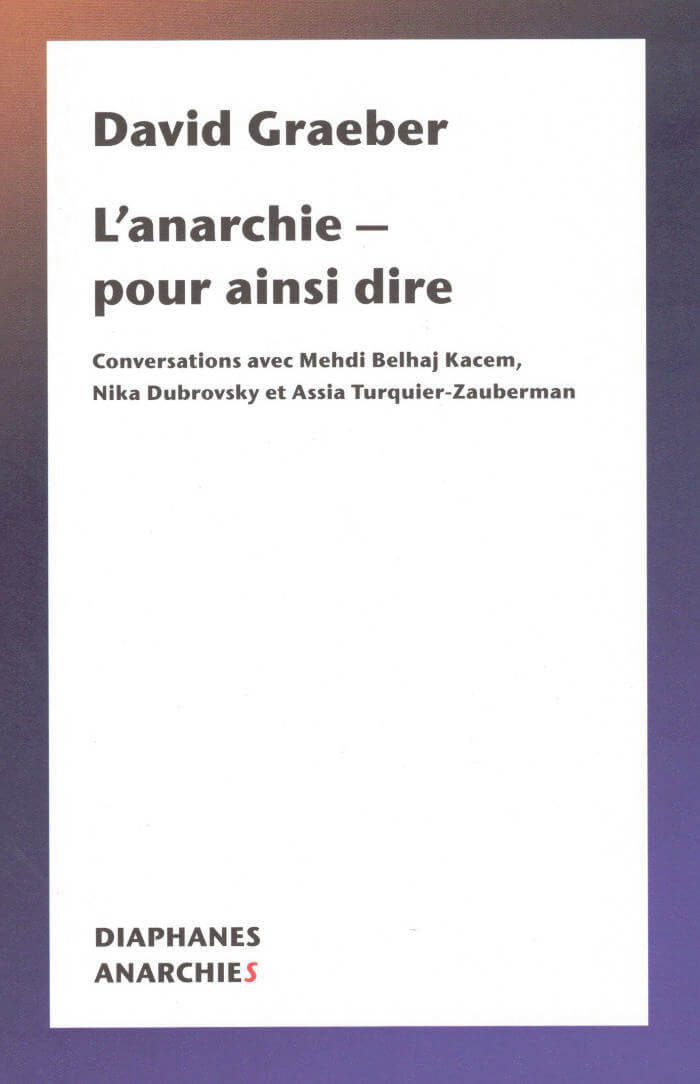
L'anarchie – pour ainsi dire
David Graeber's interviews (with Mehdi Belhaj Kacem, Nika Dubrovsky, and Assia Turquier-Zauberman) redefine the contours of what an anarchist morality could be today.
Also available in English edition.
David Graeber (1961-2020) was an American anthropologist, anarchist, political activist, the author of several books, and a leading figure in the Occupy Wall Street movement. Until 2007 he was assistant and associate professor of anthropology at Yale University, until 2013 a reader for Social Anthropology at Goldsmiths, University of London, and until last a professor of anthropology at the London School of Economics.